Unlocking the Power of Sticky Glue: Tips and Tricks

Adhesives have been essential to human civilization for thousands of years, from ancient civilizations using natural resins to modern industrial applications using advanced synthetic materials. Glue, one of the most common forms of adhesive, plays a crucial role in a wide range of applications, from arts and crafts to construction and manufacturing. In this article, we will delve into the fascinating world of glue, exploring its types, properties, applications, and sharing tips and tricks on how to make the most of this sticky substance.
Types of Glue
There are numerous types of glue available in the market, each designed for specific materials and applications. Some common types include:
1. PVA Glue
Also known as wood glue or white glue, PVA glue is widely used in woodworking, paper crafting, and other porous materials due to its strong bond and ease of use.
2. Super Glue
Super glue, or cyanoacrylate adhesive, is known for its fast-drying and strong bond on materials like metal, plastic, and ceramics. It is ideal for quick repairs and bonding small items.
3. Epoxy
Epoxy adhesives are versatile and durable, making them suitable for a wide range of materials, including metal, glass, and plastic. They provide a strong, waterproof bond when cured.
4. Hot Glue
Hot glue, or hot melt adhesive, is applied in a molten state and solidifies upon cooling. It is commonly used in crafts, DIY projects, and quick fixes due to its versatility and ease of use.
5. Rubber Cement
Rubber cement is a flexible adhesive commonly used in arts and crafts for its ability to bond paper, cardboard, and other lightweight materials without wrinkling or warping the surface.
6. Contact Cement
Contact cement is a strong, heat-resistant adhesive used for bonding materials like laminate, leather, and rubber. It forms an instant bond when the coated surfaces are pressed together.
Properties of Glue
The effectiveness of glue depends on several key properties, including:
1. Bond Strength
Bond strength refers to the maximum load a bonded joint can withstand before failing. It is crucial to select a glue with the appropriate bond strength for the intended application.
2. Drying Time
The drying time of glue varies depending on the type of adhesive and the materials being bonded. Factors such as temperature and humidity can also impact drying time.
3. Viscosity
Viscosity refers to the thickness of the glue. Low-viscosity glues flow easily into tight spaces, while high-viscosity glues are more suitable for vertical or overhead applications.
4. Curing Mechanism
Different glues cure through mechanisms such as solvent evaporation, chemical reaction, or exposure to light or heat. Understanding the curing mechanism is essential for achieving the desired bond strength.
5. Water Resistance
Some glues are water-resistant or waterproof, making them suitable for outdoor or wet environments. It is important to select a glue that can withstand the intended conditions.
Applications of Glue
Glue is used in a wide range of applications across various industries. Some common uses include:
- Woodworking: Glue is essential for joining wood pieces together in furniture making, cabinetry, and carpentry.
- Construction: Glue is used for bonding materials like tiles, flooring, and insulation in the construction industry.
- Automotive: Glue is used for assembling car parts, attaching trims, and bonding components in automotive manufacturing.
- Electronics: Glue is used for encapsulating electronic components, bonding circuit boards, and securing wires in electronic devices.
- Medical: Glue is used in medical procedures for closing wounds, sealing incisions, and attaching medical devices.
- Crafts: Glue is essential for various craft projects, including scrapbooking, model making, and DIY decorations.
Tips and Tricks for Using Glue Effectively
To ensure successful bonding and maximize the performance of glue, consider the following tips and tricks:
- Surface Preparation: Clean and dry the surfaces to be bonded to remove dirt, oil, and debris that can hinder adhesion.
- Clamping: Apply pressure or use clamps to hold the bonded surfaces together until the glue has fully cured for a strong and even bond.
- Temperature and Humidity: Optimal temperature and humidity conditions can speed up or slow down the drying and curing process of glue.
- Storage: Store glue in a cool, dry place away from direct sunlight to prevent degradation and maintain its effectiveness.
- Safety Precautions: Follow safety guidelines when using glue, including wearing gloves, ventilation in enclosed spaces, and handling flammable adhesives with care.
Frequently Asked Questions (FAQs)
Q1: How long does it take for glue to dry?
A: The drying time of glue varies depending on the type of adhesive, materials being bonded, and environmental conditions. It can range from a few seconds to 24 hours or more for full curing.
Q2: Can you paint over glue?
A: Some types of glue, such as PVA glue, are paintable once fully dried. However, certain glues may not be suitable for painting and can affect the finish.
Q3: How can I remove excess glue?
A: Excess glue can be removed using a scraper, sandpaper, or a solvent recommended for the specific type of adhesive. It is important to follow safety precautions when using solvents.
Q4: Can glue be used on all materials?
A: Different types of glue are formulated for specific materials. It is essential to select a glue that is compatible with the materials you are bonding for optimal adhesion.
Q5: How can I improve the bond strength of glue?
A: To improve bond strength, ensure proper surface preparation, apply the right amount of glue, and use clamps or pressure to hold the bonded surfaces together until the glue has fully cured.
In conclusion, glue is a versatile and indispensable adhesive that has revolutionized countless industries and applications. By understanding the types, properties, and applications of glue, as well as following tips and tricks for effective use, you can harness the power of sticky glue to achieve strong and durable bonds in your projects.




